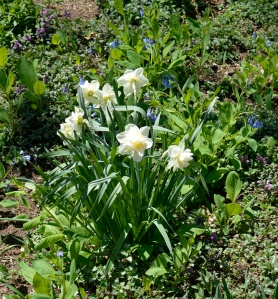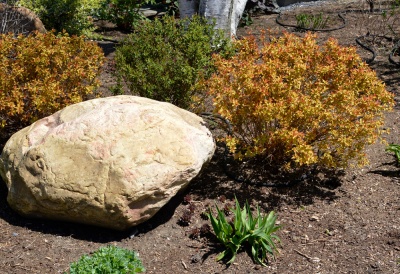Panorama of Spring
 Christina writes: Towards the end of April Wayne and I made a six-day trip to exhibitions in Washington, D.C., New York, and New Haven (about which more in a later post). Since temperatures in April had been lower than normal during the day and quite cold at night, spring at home was not as far advanced as usual this time of year. When we left Williamstown (about 43 degrees north latitude), the trees were still leafless, and of shrubs only the forsythia in a neighbour’s garden was in bloom. In our garden, lilacs, spireas, and Japanese willows were hinting that their buds were about to open. Our first few daffodils opened up only two days before our trip, always late compared with those in sunnier areas – or maybe it’s the varieties I planted. But at least we had enough rain that we did not have to begin watering as early as we did in 2012.
Christina writes: Towards the end of April Wayne and I made a six-day trip to exhibitions in Washington, D.C., New York, and New Haven (about which more in a later post). Since temperatures in April had been lower than normal during the day and quite cold at night, spring at home was not as far advanced as usual this time of year. When we left Williamstown (about 43 degrees north latitude), the trees were still leafless, and of shrubs only the forsythia in a neighbour’s garden was in bloom. In our garden, lilacs, spireas, and Japanese willows were hinting that their buds were about to open. Our first few daffodils opened up only two days before our trip, always late compared with those in sunnier areas – or maybe it’s the varieties I planted. But at least we had enough rain that we did not have to begin watering as early as we did in 2012.
 As we drove south into a more and more advanced spring, gradually bare trees gave way to fresh green leaves, and eventually to flowering varieties in full bloom, pink, white, and red, with more colour provided by the occasional rhododendron. Near the National Gallery in Washington (about 39 degrees north latitude) was a long row of azaleas thickly covered with white flowers or half-open buds. Many trees were in blossom, including some cherries, but for the most part had already passed their peak. Driving north again, in the garden of friends in Pennsylvania we found beautiful grape hyacinths and other flowers and shrubs, now in a more woodland setting. In New York City (about 41 degrees north latitude) we saw more flowering trees in Central Park, outside the Metropolitan Museum of Art, and beautiful magnolias outside the Frick Museum; while in nearby Greenwich, Connecticut, the daffodils were over, replaced by an army of tulips.
As we drove south into a more and more advanced spring, gradually bare trees gave way to fresh green leaves, and eventually to flowering varieties in full bloom, pink, white, and red, with more colour provided by the occasional rhododendron. Near the National Gallery in Washington (about 39 degrees north latitude) was a long row of azaleas thickly covered with white flowers or half-open buds. Many trees were in blossom, including some cherries, but for the most part had already passed their peak. Driving north again, in the garden of friends in Pennsylvania we found beautiful grape hyacinths and other flowers and shrubs, now in a more woodland setting. In New York City (about 41 degrees north latitude) we saw more flowering trees in Central Park, outside the Metropolitan Museum of Art, and beautiful magnolias outside the Frick Museum; while in nearby Greenwich, Connecticut, the daffodils were over, replaced by an army of tulips.
 Spring began to recede as we returned north, but back at home we found many more daffodils out in our garden, and most of our shrubs had small, tender leaves. Hostas, not visible at all when we left, were just emerging. During the last few days of April, I was busy in the garden. Rather later than usual, because our trip prevented frequent watering of new plants, I bought and planted some violas (twelve six-packs) to edge some of the beds – fewer than during the past few years, but the place where I usually found a good and varied supply had already sold most of its stock. I also spent time cutting away dead or winterburn-damaged leaves from underneath the new growth of brunnera, heuchera, and astilbe. Since the ground was very dry after only one rainfall during our absence, Wayne got three hoses out of the garage and linked them to faucets. Mainly using sprinklers for a couple of hours each day, everything except the lawns had been watered by Tuesday this week.
Spring began to recede as we returned north, but back at home we found many more daffodils out in our garden, and most of our shrubs had small, tender leaves. Hostas, not visible at all when we left, were just emerging. During the last few days of April, I was busy in the garden. Rather later than usual, because our trip prevented frequent watering of new plants, I bought and planted some violas (twelve six-packs) to edge some of the beds – fewer than during the past few years, but the place where I usually found a good and varied supply had already sold most of its stock. I also spent time cutting away dead or winterburn-damaged leaves from underneath the new growth of brunnera, heuchera, and astilbe. Since the ground was very dry after only one rainfall during our absence, Wayne got three hoses out of the garage and linked them to faucets. Mainly using sprinklers for a couple of hours each day, everything except the lawns had been watered by Tuesday this week.
 By last Sunday, daytime temperatures climbed into the high 60s and low 70s Fahrenheit, and all of the plants seemed to be trying to make up for lost time. Hostas appeared to grow about an inch a day; the Virginia bluebells came into flower, as did some of the brunnera; our grape hyacinths pushed up; the PJM rhododendron likewise flowered, with the viburnum and bleeding hearts following after; and periwinkle is in wild profusion. Yesterday, I noticed that the lavender in our front garden was showing the first hints of green, and that yellow waxbells were just emerging from the ground. On Tuesday, with the grass already quite high, our landscaper, Dan, cut our lawns for the first time this season with his riding mower. The following day, his men edged the flower beds that adjoin lawns, and also laid soaker hoses (which Wayne had sorted and labelled) on some of the beds, while Dan spent a short time trimming and pruning. Today the men mulched the garden. Now, apart from some periodic fertilizing and planting any larger shrubs we add, everything will be mainly in our hands. We’ll lay sprinkler hoses on three other beds and water as needed (and as allowed by the town, if we get drought conditions again). Wayne will be doing the later mowing and I will begin a new, constant round of weeding, dead-heading, and trying to keep edges clear.
By last Sunday, daytime temperatures climbed into the high 60s and low 70s Fahrenheit, and all of the plants seemed to be trying to make up for lost time. Hostas appeared to grow about an inch a day; the Virginia bluebells came into flower, as did some of the brunnera; our grape hyacinths pushed up; the PJM rhododendron likewise flowered, with the viburnum and bleeding hearts following after; and periwinkle is in wild profusion. Yesterday, I noticed that the lavender in our front garden was showing the first hints of green, and that yellow waxbells were just emerging from the ground. On Tuesday, with the grass already quite high, our landscaper, Dan, cut our lawns for the first time this season with his riding mower. The following day, his men edged the flower beds that adjoin lawns, and also laid soaker hoses (which Wayne had sorted and labelled) on some of the beds, while Dan spent a short time trimming and pruning. Today the men mulched the garden. Now, apart from some periodic fertilizing and planting any larger shrubs we add, everything will be mainly in our hands. We’ll lay sprinkler hoses on three other beds and water as needed (and as allowed by the town, if we get drought conditions again). Wayne will be doing the later mowing and I will begin a new, constant round of weeding, dead-heading, and trying to keep edges clear.
 I think that this is my favourite time of year, because almost everything in the garden is still to come. Only the early snowdrops and dwarf iris have already died away. From now on, as I welcome each new bush or plant that flowers I will also be sad to see blossoms fade. Perennials demand less work, since most survive from year to year, but most have a relatively short period of flowering. That is why at the end of May, when there should be no further chance of frost for the season, I’ll plant some areas with annuals which have a long flowering life.
I think that this is my favourite time of year, because almost everything in the garden is still to come. Only the early snowdrops and dwarf iris have already died away. From now on, as I welcome each new bush or plant that flowers I will also be sad to see blossoms fade. Perennials demand less work, since most survive from year to year, but most have a relatively short period of flowering. That is why at the end of May, when there should be no further chance of frost for the season, I’ll plant some areas with annuals which have a long flowering life.
Images (top to bottom, all taken before mulch was laid, some showing how dry the ground has been): daffodils, among Virginia bluebells and lamium, in our main perennial bed; daffodils, grape hyacinths, and pachysandra in the more wild garden around azaleas and rhododendrons; new violas, with a daylily and part of a soaker hose bordering holly bushes and a rose of Sharon; two kinds of spirea, daylily, sedum, hens and chicks, and one of our landscape boulders in the bed immediately in front of our house; periwinkle flowering among the occasional dead leaf and beneath lilac and viburnum by the street.

Comments are closed.